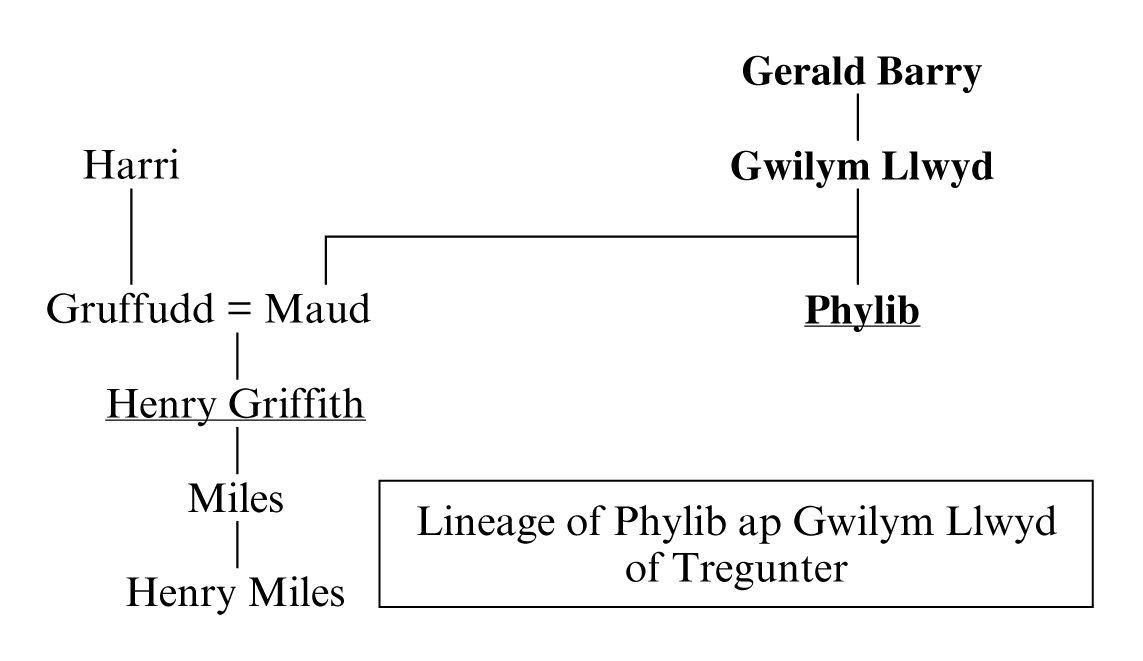Phylib ap Gwilym Llwyd was the patron of poem 30.
Lineage
The lineage of Phylib son of Gwilym Llwyd son of Gerald Barry is given in WG2 ‘Barry’ 3. Those named in Guto’s poem for Phylib are shown in bold print, and the names of patrons are underlined.

Lineage of Phylib ap Gwilym Llwyd of Tregunter
Bartrum tentatively suggests that there was a second Gwilym Llwyd between Phylib and Gerald. Guto’r Glyn’s poem makes this unlikely. In lines 11–16 Guto traces Phylib’s lineage in the usual way, moving from son to father to, surely, the grandfather, calling Phylib ŵyr Gerallt (30.16). It is true that ŵyr can mean great-grandson as well as grandson, but the natural progression would be to name the grandfather after the father. Most likely, then, ŵyr means ‘grandson’ here. Phylib was, if this is correct, a brother of Maud, the wife of Henry Griffith of Newcourt in Bacton, another of Guto’r Glyn’s early patrons.
His locality
We learn from Guto’s poem that Phylib lived somewhere in the Wye Valley, near Talgarth (30.10, 24), and it appears that his home was actually Tregunter (Trefgwnter in Welsh, 30.48). Tregunter is the name of a farm about a mile west of Talgarth (SO 135339), and there was formerly a mansion there which was demolished early in the twentieth century (Gunter 1988–9: 47–8). In 1524, when an inquisition was held into the lands of Henry Miles, a grandson of Henry Griffith, Tregunter was among them (Richardson and Hubbard 2010). Its worth was £4. Richardson and Hubbard state that it came into the possession of Henry Miles’s family as part of Maud’s dower. The date of Maud’s marriage to Gruffudd ap Harri is not known, but the couple’s son, Henry Griffith, was old enough to witness a grant with his father in 1425. It is possible, then, that Phylib lived at Tregunter by permission of Gruffudd or Henry, and indeed that he was their tenant.
It seems that Phylib also held lands at a place called Maleiniog (30.56). This manor was located on both banks of the river Wye, near Llanigon and Hay-on-Wye (Dawson 1918: 308–10). It is called Melinog in some sources, which is the form under which it occurs on William Rees’ map (1932), which places it between Glasbury and Llowes (SO 1840); it is spelled Melynog in WATU 155. It is unclear whether this accounts for Guto’s description of Phylib as ‘eagle of Llowes’ (30.41), or whether Phylib held further lands in Llowes itself. In 1524 Melinog too was part of the lands which had been left by Henry Miles (Richardson and Hubbard 2010). Its worth was 53s 4d. According to these references both Tregunter and Melinog belonged to the lordship of English Talgarth. Tregunter is still within the parish of Talgarth today, but it is unclear how Melinog relates to that lordship.
His dates
Since poem 30 is extant in Pen 57 (c.1440), it must have been composed before then, most likely in the 1430s. That gives Phylib a floruit in the 1430s. We have no more precise information about his dates.
Bibliography
Dawson, M.L. (1918), ‘Notes on the History of Glasbury’, Arch Camb (sixth series) xviii: 279–319
Gunter, G.W. (1988–9), ‘The Descent of Tregunter’, Brycheiniog, xxiii: 47–8
Rees, W. (1932), South Wales and the Border in the Fourteenth Century (Southampton)
Richardson, R.E. and Hubbard, S. (2010), ‘Parry Lands in 1524, 1543, 1544 & 1545’ in http://www.blancheparry.co.uk/pdf/property_of_blanches_family.pdf





